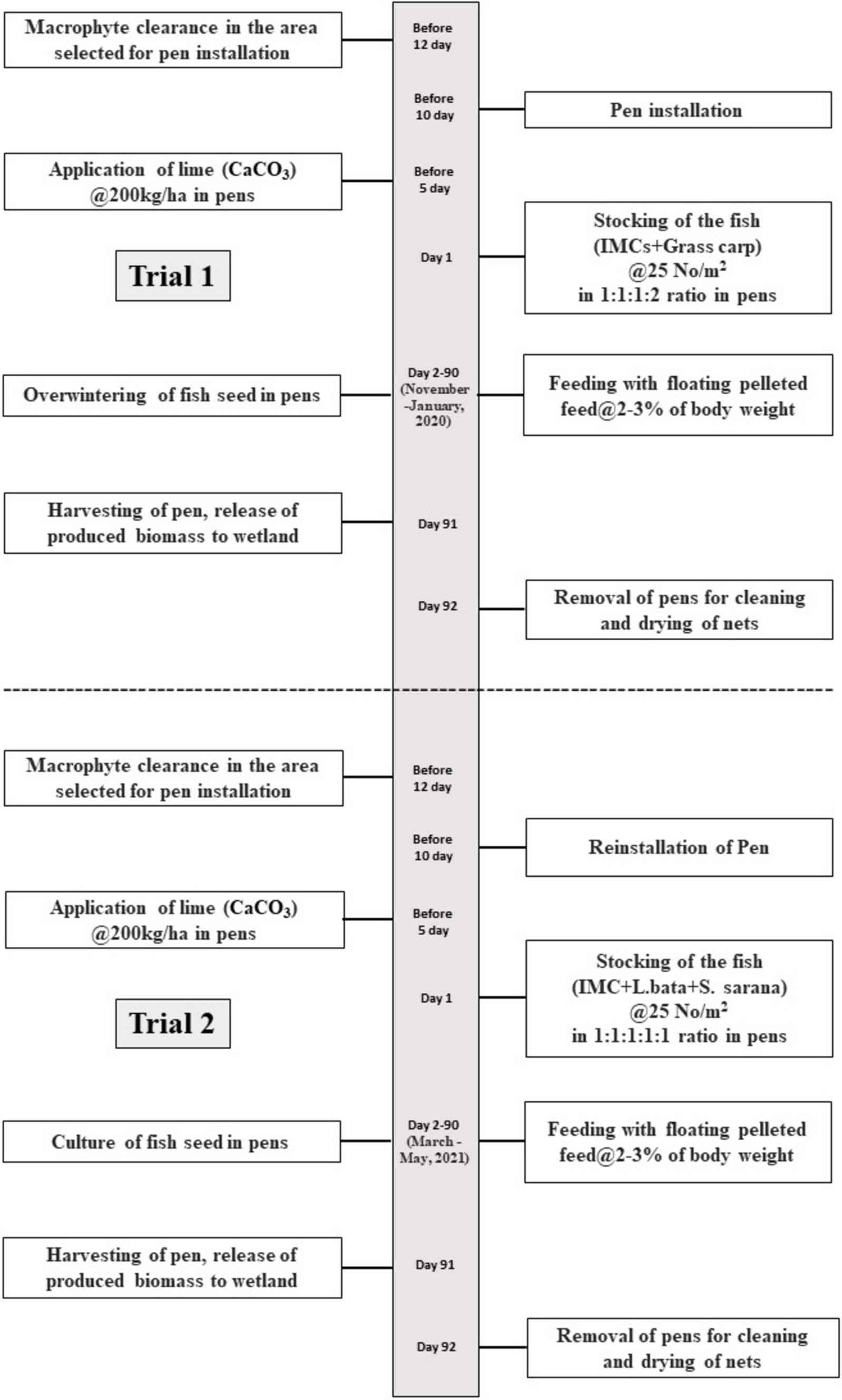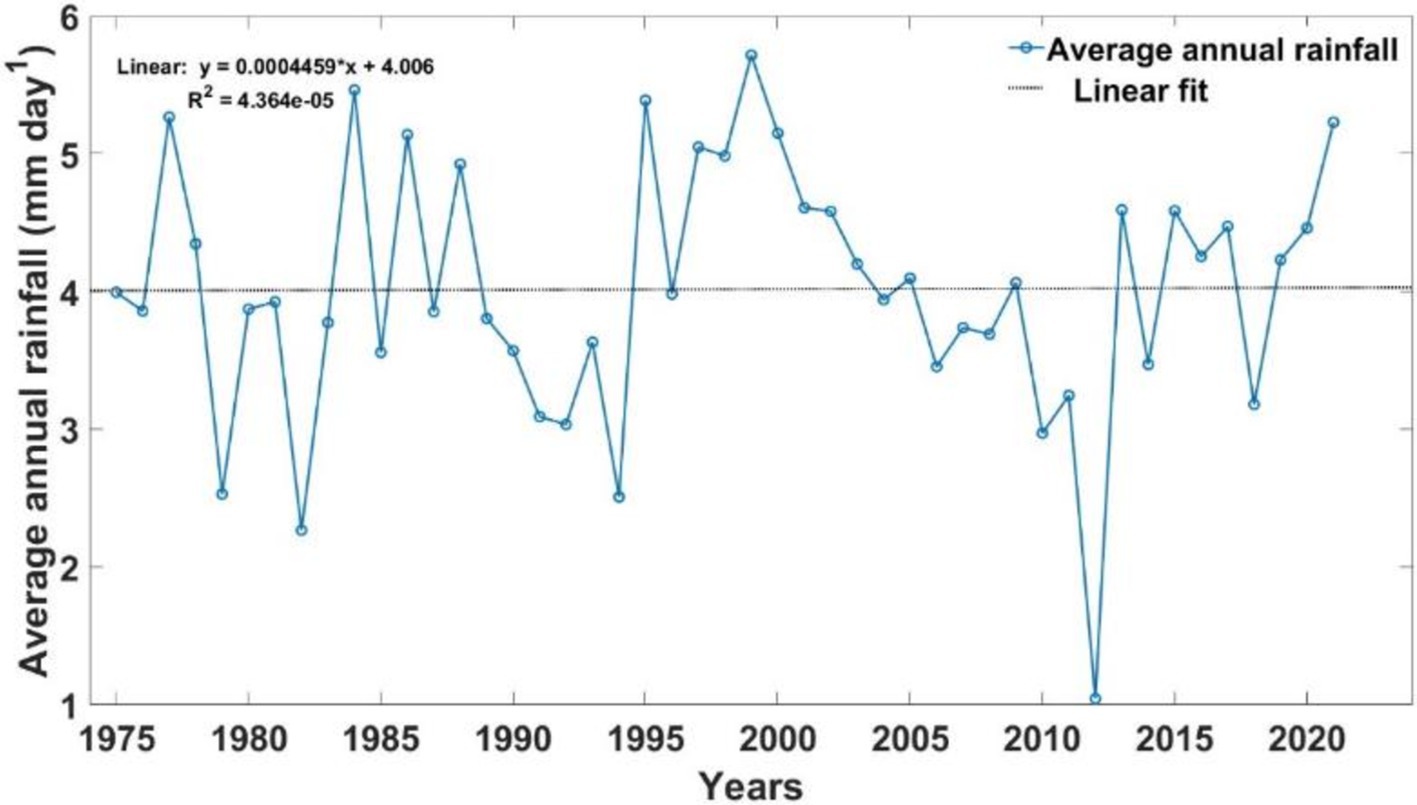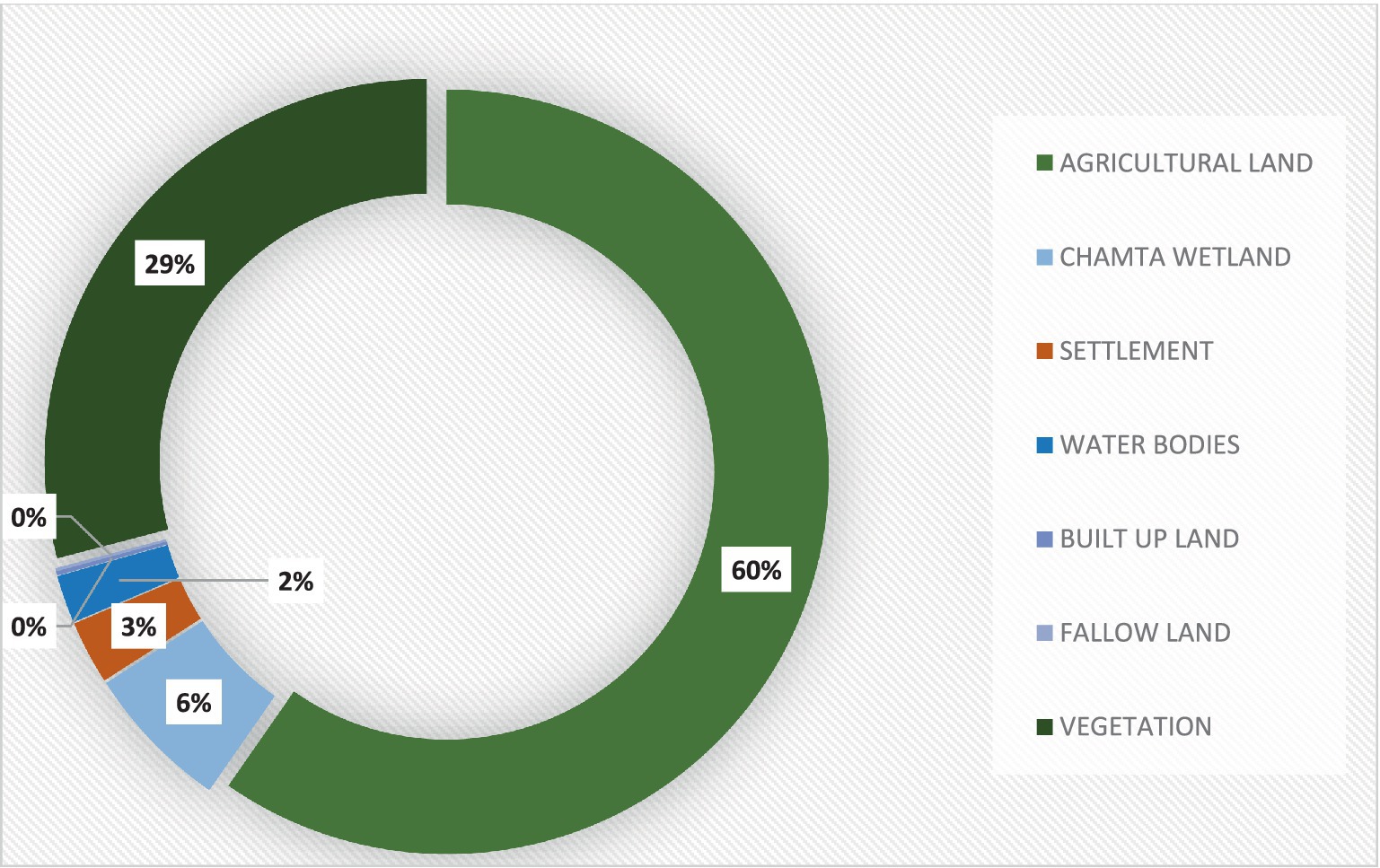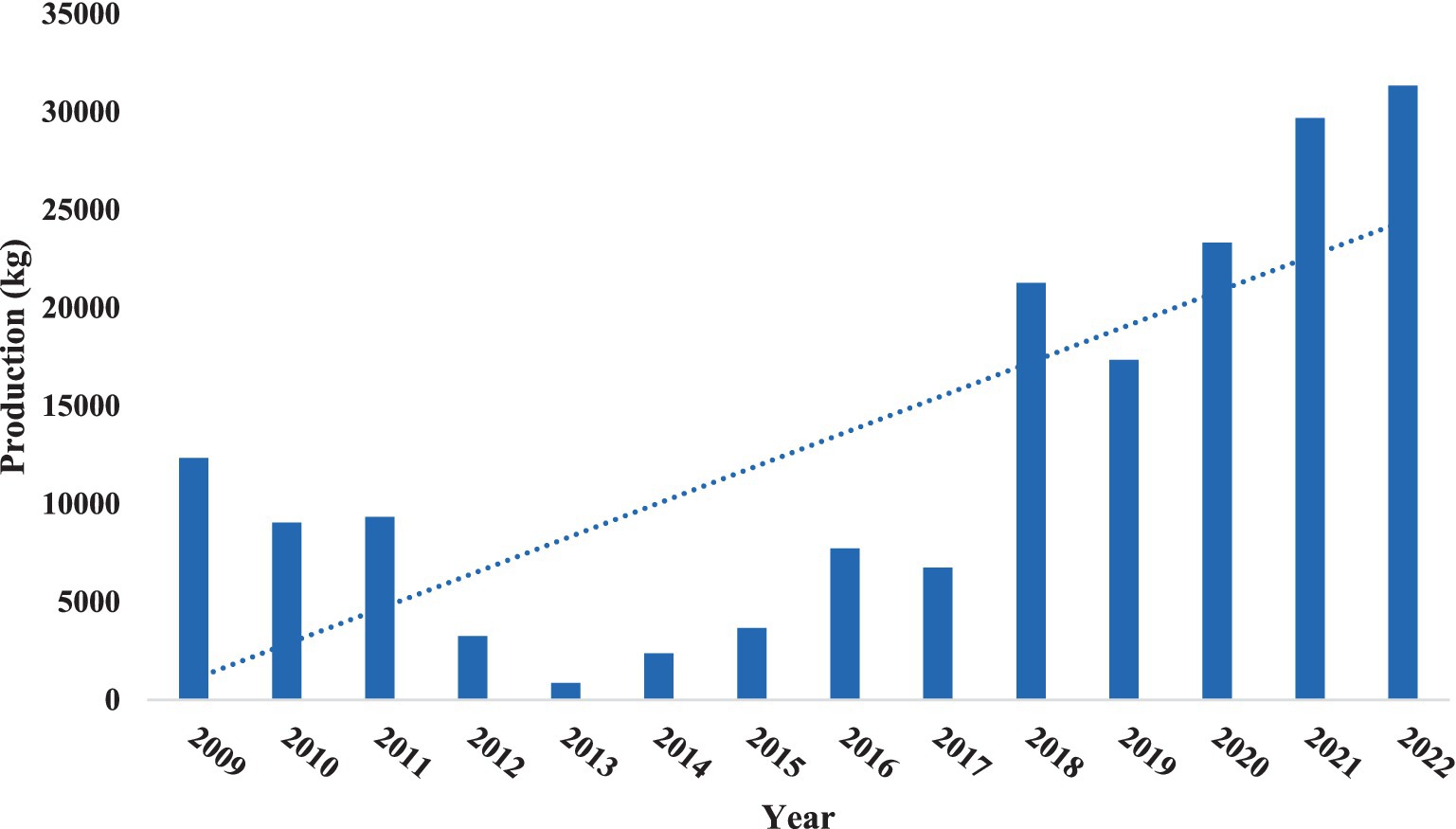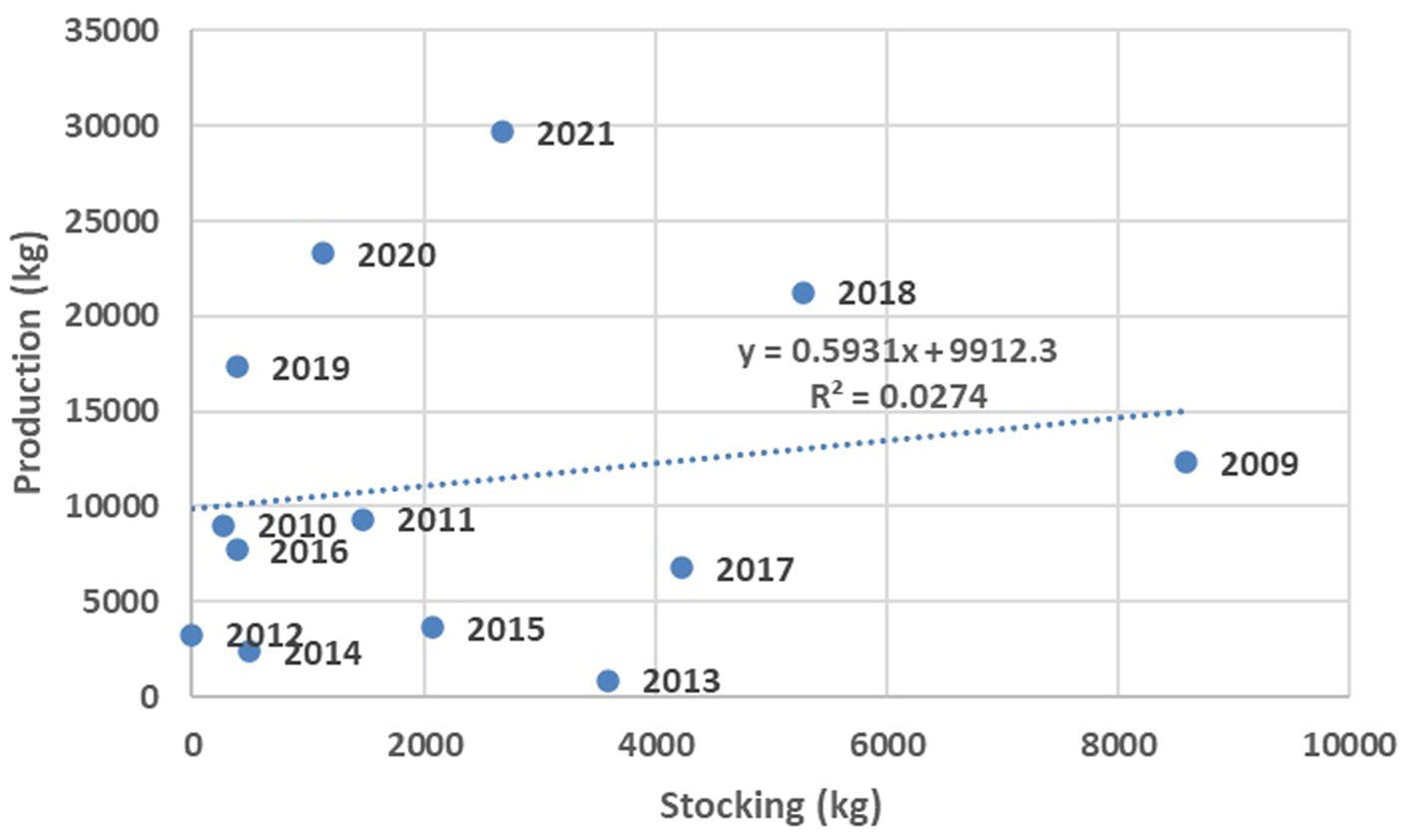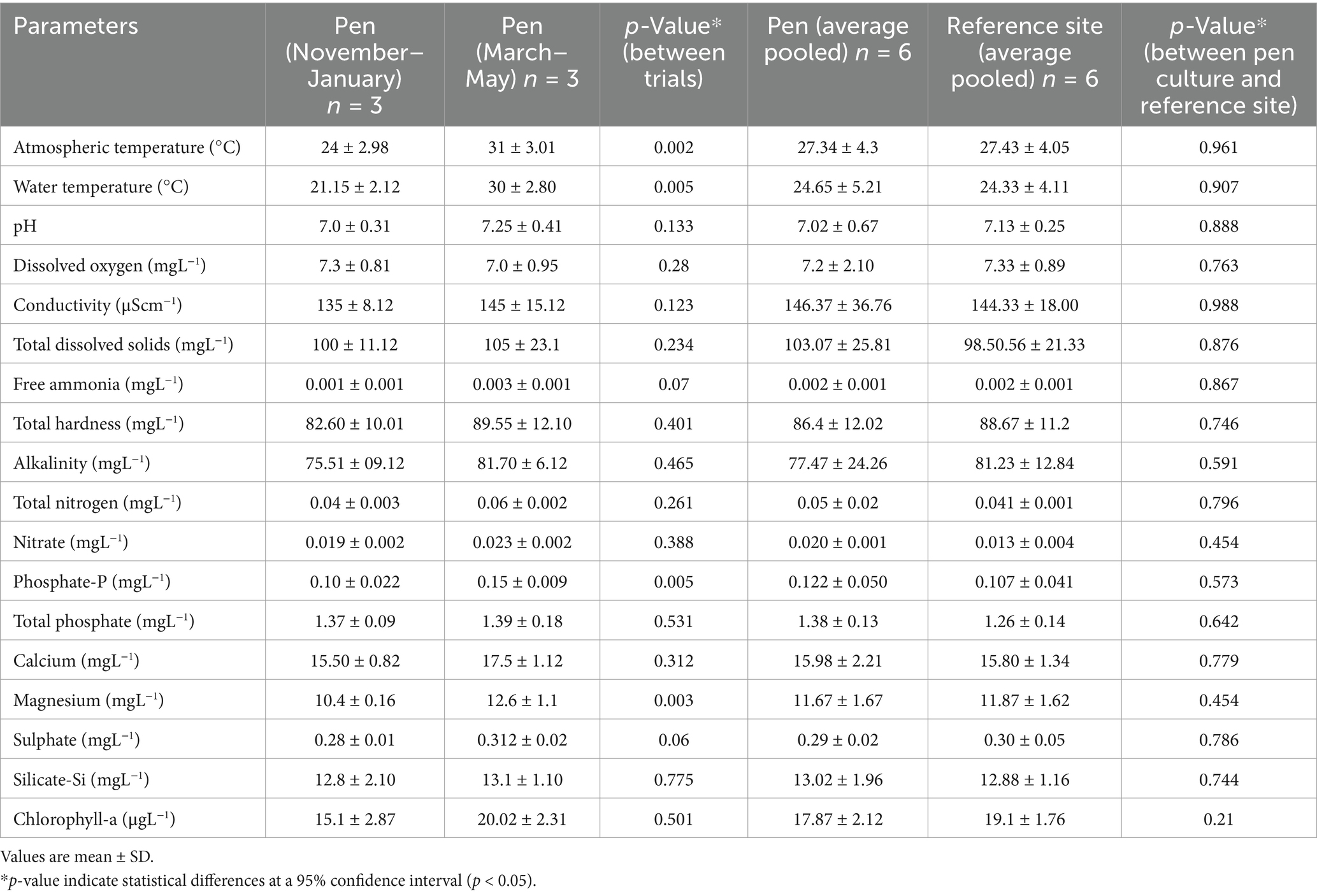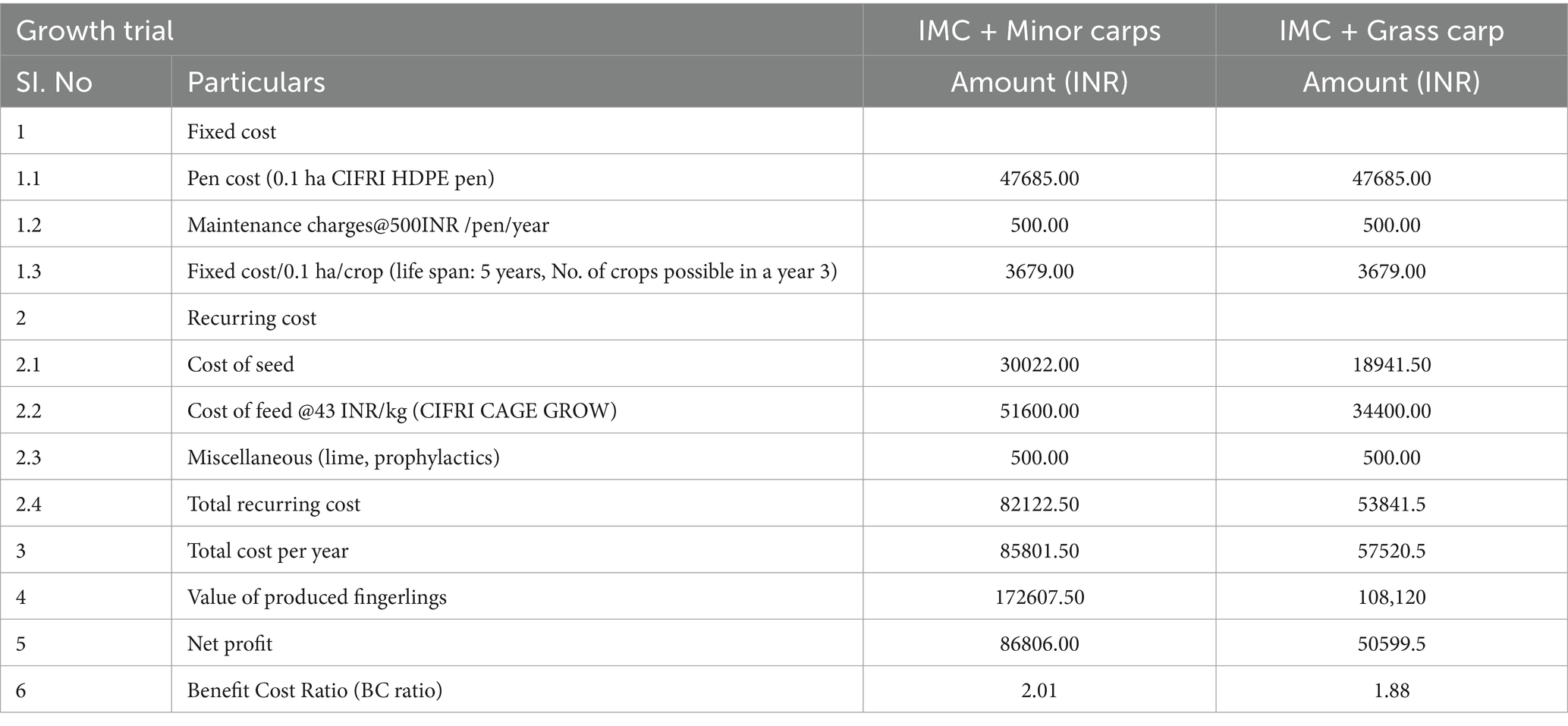- 1ICAR-Central Inland Fisheries Research Institute, Kolkata, India
- 2Caribbean Regional Fisheries Mechanism, Kingstown, Saint Vincent and the Grenadines
The present study deals with stakeholder-driven implementation of pen culture for raising of fish seed for Culture-based fisheries (CBF) in Chamta, a floodplain wetland, in Gangetic plains through polyculture of Indian Major Carps (IMCs) Labeo catla, Labeo rohita and Cirrhinus mrigala with Small Indigenous Fishes (SIFs) Labeo bata, Systomus sarana and grass carp, Ctenopharyngodon idella in co-management mode. In the first polyculture trial IMCs and minor carps were cultured in 4 High Density Poly Ethylene (HDPE) pens (0.1 ha each) at a stocking density of 25 Nos. m−3 in equal numbers for 90 days. In the second polyculture trial IMCs were cultured with grass carp at a density of 25 Nos. m−3 in 4 HDPE pens in the ratio of 1:1:1:2 for 90 days. The same set of pens was utilized for both trials during different times of the year. Net yield of 682.3 ± 20.6 kg and 413.9 ± 21.7 kg per pen was achieved through polyculture of IMCs and SIFs and polyculture and for IMCs and grass carp, respectively. The survival percentage varied with species and culture period with overall survival of 77 (IMCs + minor carps) to 85% (IMCs + grass carp). Polyculture was economically feasible with a BC ratio of 2.01 for IMC and SIFs and 1.88 for IMC and grass carp. All the seeds produced in the pens were released to the wetland as input for CBF. The study indicated the potential of grass carp fishery in macrophyte-infested wetland. The species could attain 1.5–2 kg in 6 months and up to 3–3.5 kg weight within 1 year, utilizing macrophyte resources of the wetland. SIFs S. sarana and L. bata were observed to attain maturity in pens. The study indicated pen as an economically feasible technology to boost CBF in the wetland. The cultivation of SIFs through pen culture and CBF can enhance their production while alleviating pressure on their natural populations. Integrating pen culture using diversified species will promote sustainable fisheries management in these floodplain wetlands.
1 Introduction
Fisheries is one of the most important services that provides food and livelihood support to the dependent rural populace living near aquatic ecosystems (Jha et al., 2013). Wetlands are one of Earth’s most productive and ecologically sensitive aquatic ecosystems. They provide multiple goods and services to human beings. They act as major carbon sinks and produce high-quality protein in the form of fish, utilizing natural productivity and converting the accumulated carbon to blue carbon in the form of fish (Karnatak et al., 2022). India is endowed with vast floodplain wetland resources located mainly in the Ganga and Brahmaputra basins in the states of Assam, West Bengal and Bihar (Sarkar et al., 2020).
Wetland fisheries in India faces several challenges, particularly due to the unsustainable practices governing their operation. The natural fish production from these wetlands has also declined over the years due to anthropogenic factors viz. pollution, water abstraction, dam construction, overexploitation, etc. (Aziz et al., 2021; Pandit et al., 2021). These fisheries, often managed by Fishermen’s Cooperative Societies (FCS), incorporate both capture fisheries (exploiting natural fish fauna) and culture-based fisheries (CBF) that rely on the capture of stocked species. However, CBF practices in these wetlands are largely arbitrary and predominantly focus on Indian Major Carps (IMCs) alongside Chinese exotic carps.
Scientific stocking protocols, such as the appropriate size at stocking and optimal stocking densities, are frequently overlooked. Fish fry and fingerlings are sourced from fish farmers or middlemen based on availability, often without ensuring quality or suitability. A critical bottleneck is the lack of infrastructure for producing high-quality fingerlings essential for CBF in open waters (Vasudevappa and Sultan, 2013). Transporting advanced fingerlings recommended for better survival also encounters challenges, including high transportation mortality and poor survival rates in wetlands due to stress during transit.
Another significant concern is the declining abundance of indigenous fish species, including Small Indigenous Fishes (SIFs). These fishes, while regularly captured by fishermen, are excluded from the CBF framework, which predominantly prioritizes larger carps. Most FCS fail to document SIF catches in fish production records, contributing to their neglect. Overexploitation, habitat degradation, and inadequate natural recruitment have drastically reduced the populations of these native species across many wetlands.
Climate anomalies in recent decades have exacerbated the degradation of wetland ecosystems, posing significant threats to the livelihoods of fishers reliant on these resources. One major ecological issue is the proliferation of macrophytes, driven by reduced water depth and nutrient enrichment, which disrupts wetland ecology and adversely affects fisheries (Sarkar et al., 2021). A sustainable strategy to address this challenge involves the introduction of macrophyte-consuming fish species. These species can convert accumulated “green carbon” (from excessive macrophyte growth) into “blue carbon” (fish), thereby enhancing fish production in macrophyte-choked wetlands. This ecosystem-based approach to CBF not only boosts fish yields but also supports habitat restoration and management, ensuring the long-term sustainability of wetland ecosystems.
Pen culture presents an effective solution to address these challenges and enhance fish production in floodplain wetlands. This technology, well-suited for seed raising and table fish production (Paul et al., 2019), can significantly improve the sustainability and productivity of wetland fisheries. Pen culture facilitates the in situ raising of advanced fingerlings in the same aquatic environment where they will be stocked, thereby increasing survival rates and reducing transportation stress (Roy and Hassan, 2013).
Additionally, pen culture supports the conservation and sustainable exploitation of SIFs. It can be employed for culturing self-recruiting indigenous species (Yengkokpam et al., 2022), helping to restore their populations while ensuring their inclusion in wetland fishery management. Moreover, pen culture diversifies the livelihood options of fishers dependent on small-scale fisheries, thereby enhancing their adaptive capacity and economic resilience (Paul et al., 2021; Karnatak et al., 2021c). Although the integration of pen culture into wetland fisheries offers a promising pathway for addressing such limitations in CBF practices, its adoption by fishermen cooperatives is very low, mostly due to a lack of awareness about the technology and capacity to implement the technology. Demonstration of such in situ technologies in co-management mode is an effective mode of technology dissemination following “learning by doing.”
The state of West Bengal has vast floodplain wetland resources (42081.65 ha), 51.21% of which are presently under CBF (DoF West Bengal, 2016). Chamta is a closed oxbow lake located in the basin of Ichamati, a tributary of the River Jamuna in the State of West Bengal. The fishery of the wetland is governed by the “Chamta Fishermen’s Cooperative Society” established in the year 1976, which has 248 registered members, mostly (90%) belonging to backward communities. The total area of the wetland is 111.47 acres, of which 61.4 acres is leased, and the rest is owned by the society. The wetland harbours more than 20 species of macrophytes, covering 60–70% of the wetland area. Most of the wetlands in West Bengal do not use pen culture technology due to a lack of knowledge.
Pen culture technology, when implemented in a co-management mode, enhances fish production in floodplain wetlands by optimizing seed size and stocking practices while conserving Small Indigenous Fishes (SIFs) and maintaining ecological balance. This hypothesis reflects the study’s aim to test the effectiveness of pen culture systems in improving fish production and promoting sustainable management practices in wetlands like Chamta while addressing the challenges of ecosystem degradation and declining indigenous fish stocks.
2 Materials and methods
The methodology involves the installation of High Density Poly Ethylene (HDPE) pens and the monitoring of stocked fish through the measurement of fish growth, water quality, and climate conditions, as well as evaluating the economic feasibility. It is discussed under following headings.
2.1 Pen culture: installation and demonstration
The pens were installed in Chamta wetland (23° 7′1.87″N, 88°41′45.05″ E) located in the North 4 Parganas district of West Bengal (Figure 1) in the month of October 2020. The study site map, including the land use pattern, was prepared in ArcGIS 10.2.1. The data on fish production from the wetland was taken from audit reports maintained by the Chamta Fishermen Cooperative Society. These reports contained information such as the quantity of fish harvested and revenue generated from the wetland over a specific period.
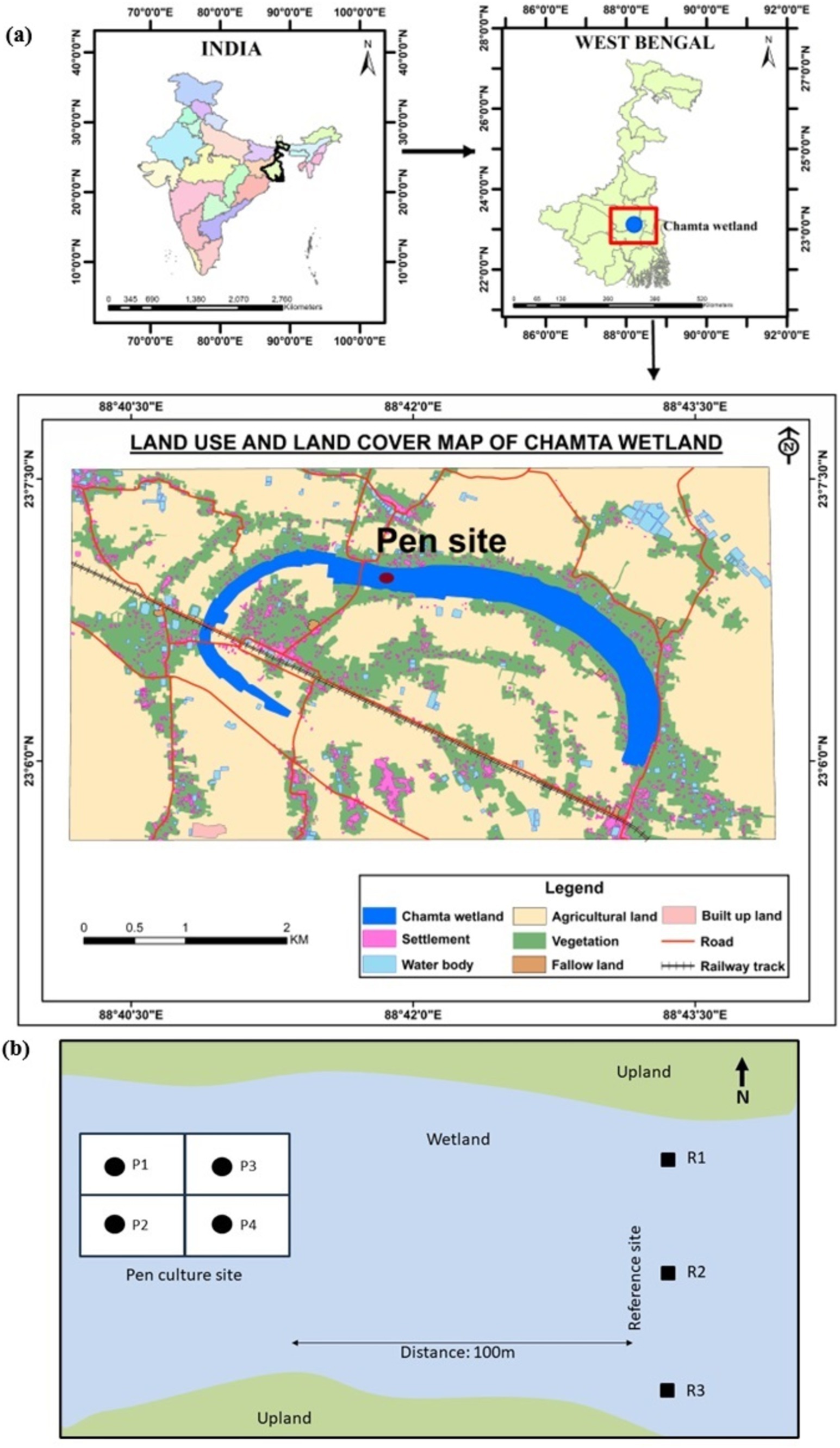
Figure 1. GIS map of the study area with pen culture site (A) and diagrammatic illustration of the pen culture setup and reference sites for water quality monitoring in the wetland (B).
The pen culture was implemented in a co-management mode involving the FCS. This involvement ensured that the local community, particularly the fishermen who rely on the wetland for their livelihoods, had a stake in the management and success of the project. Each pen unit had an effective water area of 0.1 ha. The pen was made from HDPE net and FRP poles (10 ft) for support. Each polyculture trial was conducted for 90 days with 4 replicates (0.1 ha/replicate). In the first polyculture trial (November 2020–January 2021), IMCs Labeo catla (4.65 ± 0.71 g), Labeo rohita (3.21 ± 0.23 g) and Cirrhinus mrigala (1.69 ± 0.19 g), and Grass carp Ctenopharyngodon Idella (5.18 ± 0.34 g) were stocked at the rate of 25 No. m−3 in the ratio of 1:1:1:2 to overwinter the seed. Overwintering fish seeds facilitates the timely availability of large-sized fingerlings for grow-out stocking, ensuring alignment with optimal seasonal conditions. This approach capitalizes on compensatory growth, enabling faster attainment of market size while reducing production time. It is a cost-effective and sustainable strategy, requiring minimal inputs in the form of maintenance rations, thereby exerting minimal environmental impact. Moreover, overwintered fingerlings exhibit enhanced health, greater resilience to environmental stressors, and improved survival rates, contributing significantly to higher overall productivity.
In the second polyculture trial (March–May 2021), IMCs Labeo catla (7.81 ± 0.54 g), Labeo rohita (5.8 ± 0.21 g), and Cirrhinus mrigala (3.65 ± 0.19 g) were cultured with minor carp Labeo bata (5.33 ± 0.33 g) and Systomus sarana (6.1 ± 0.15 g) at a stocking density of 25 Nos. m−3 in the ratio of 1:1:1:1:1. In both trials, fish were fed with floating pelleted feed (CP-28%, CL-4%) at the rate of 2 to 3% of body weight per day divided in two equal instalments and fed twice a day (10:00 h, 16:00 h) (see Figure 2).
2.2 Water quality and climate trend
Water quality was assessed from all pens at the reference site (100 m away from the pen) during the culture trials. The samples were collected monthly during 8–9 h from all pens and reference sites (n = 3). The air temperature was recorded using a mercury thermometer. Water temperature, specific conductivity, total dissolved solids (TDS), and pH were recorded using a multiparameter probe (Eutech). Alkalinity and hardness were estimated onsite using the titrimetric method. Other water quality parameters (Free ammonia, Total nitrogen, Nitrate, Available phosphate, Total Phosphate, Calcium, Magnesium, Sulphate, Silicate and Chlorophyll-a) were analysed in the laboratory using standard methods (APHA, 2012). The grid data annual mean (Tmean), maximum (Tmax) and minimum (Tmin) average air temperature (1° × 1°) and annual average rainfall (0.25° × 0.25°) were obtained from IMD, Govt. of India, for a period from 1975 to 2021 (Pai et al., 2014; Srivastava et al., 2009). Linear regression was done for trend analysis, and a linear fit of the data was delineated to generate a trendline for the climate data.
2.3 Growth, survival and feeding efficiency
Growth was assessed in form of weight gain (WG), weight gain percent (WG%), specific growth rate (SGR), Average Daily Growth (ADG), and feeding efficiency was estimated using the feed conversion ratio (FCR), protein efficiency ratio (PER), and feed conversion efficiency (FCE), while survival percent was calculated by sorting and counting the number of individuals at the end of the experiment using standard formulas (Karnatak et al., 2021b):
2.4 Economics
The benefit–cost ratio (BC ratio) was estimated to indicate the economic feasibility of the pen culture. Economic analysis considered the total input cost and the prevailing market price of the produce in a single unit of pen. The fixed cost year−1 pen−1 was worked out considering 5-year durability. Total cost was calculated, including fixed cost (cost of pen/year, maintenance cost) and recurring cost (feed cost, seed cost, chemicals). The total value of the produced fingerlings was assumed at the prevailing market price for individual species at the produced size. The prevailing price of the produced fingerlings at the time of harvest was 200 INR per kg for IMCs, 375 INR per kg for S. sarana, 300 INR per kg for L. bata, and C. idella. The price was multiplied by the net yield of each species to estimate the total value of produced fingerlings. The net benefit was calculated by subtracting the total production cost from the cost of the fingerlings produced in pens. The BC ratio was estimated using the following formula:
2.5 Statistical analysis
The data analysis was performed using SPSS software (Ver 14). Growth data from each pen was treated as an independent sample. Descriptive analysis (mean and standard deviation) was done for growth parameter. Water quality parameters were compared using a t test at a 95% confidence interval. The water quality data from pens and reference sites were pooled on monthly basis for comparison of means. The relationship between stocking and fish production in the wetland (2009–2021) was analysed using correlation coefficient and linear regression. The graph depicting time series change in average annual temperature and rainfall in the study area was generated using Matlab 2021 software.
3 Results
3.1 Climate and fish production trend
Climate trend analysis indicated a warming trend in the study area (Figure 3). Annual Tmean and Tmin minimum showed an increasing trend, while Tmax showed a decreasing trend. However, the R2 value for the linear fit for Tmean and Tmax were found to be insignificant, whereas the fit for Tmin was estimated to be significant (R2 = 0.40). Annual precipitation showed statistically insignificant change over the last 45 years (Figure 4). The land use pattern of the wetland showed that the catchment is dominated by agriculture (60%), followed by vegetation other than field crops, including natural vegetation (29%). The wetland constitutes around 6% of the area, while settlements and other water bodies contribute roughly 3 and 2% of the total area (Figures 1, 5).
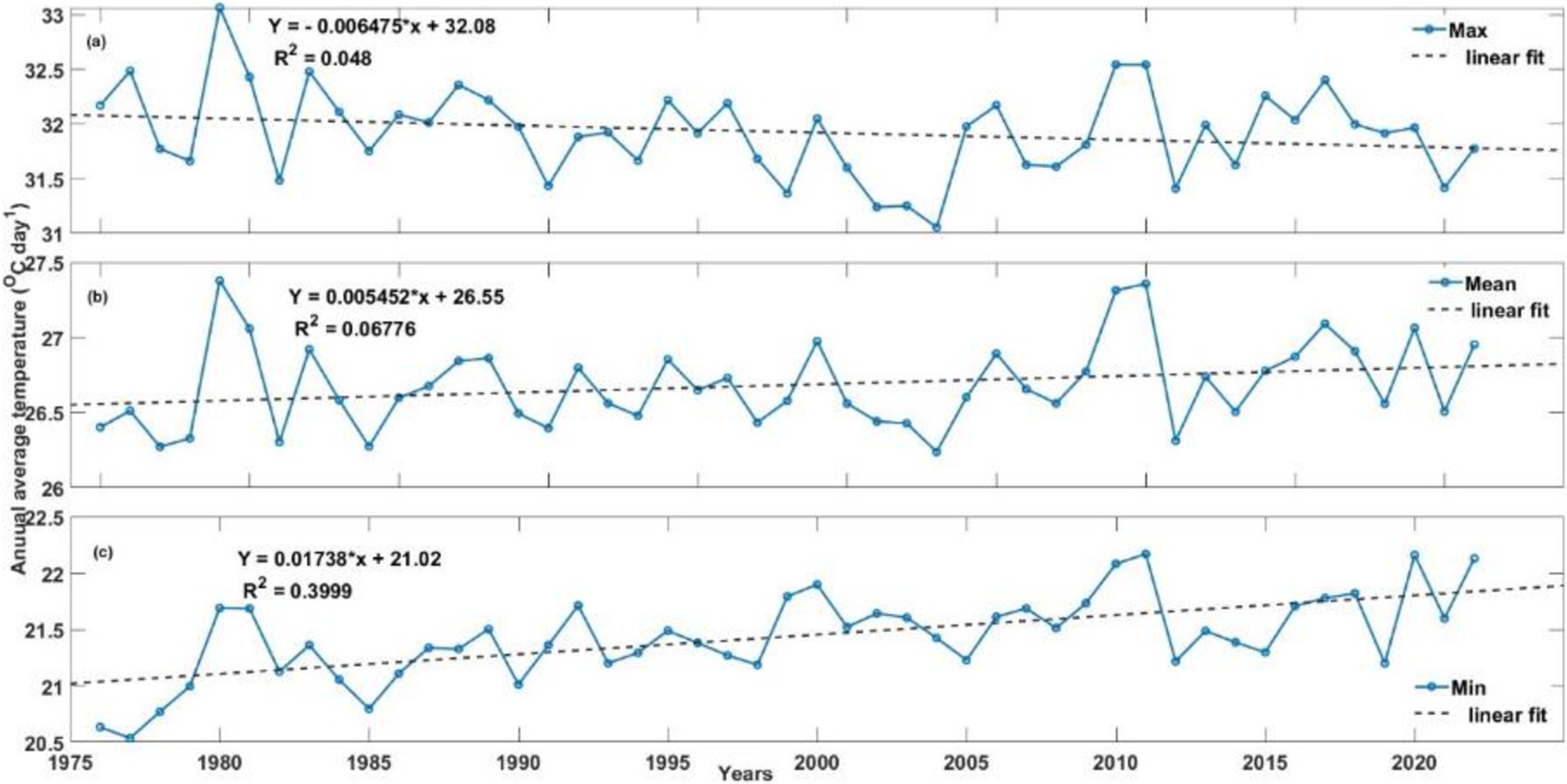
Figure 3. Temperature trend [(A) Maximum, (B) Mean, (C) Minimum] in the study area in last four decades.
The fish production from the wetland in the last decade (2009–2019) varied from 862 kg to 12,349 kg (Figure 6) due to arbitrary and unscientific stocking practices. The stocking in the wetland varied from 8,579 kg (2009) to nil stocking (2012), with no defined size and stocking time. The stocking and fish production data from the wetland correlated positively (r = 0.16); however, the relationship was insignificant (R2 = 0.027) (Figure 7). The implementation of pen culture technology in the wetland contributed to a significant increase in overall fish production, rising from 23,326 kg in 2020 to 29,680 kg in 2021, and further to 31,337 kg in 2022. While the release of advanced fingerlings through pen culture by the Fishermen Cooperative Society (FCS) likely played a significant role in this growth, the potential contribution of other environmental and ecological factors influencing natural productivity and habitat suitability cannot be ruled out.
3.2 Growth, survival and feeding efficiency
The growth of the fish in pens varied with species and also with season. In the polyculture of IMCs and minor carps, L. catla, L. rohita, and C. mrigala attained an average size of 41.37 ± 3.05, 30.54 ± 1.46 and 21.20 ± 1.47 g, respectively, while minor carps attained an average size of 38.98 ± 2.26, and 27.75 ± 3.26 g, respectively. L. catla and S. sarana showed significant (p < 0.05) growth over other species. The weight gain percentage was highest for S. sarana and lowest for L. bata. Among IMCs, the weight gain % and SGR were highest in C. mrigala. The overall survival percentage was 85% (82–87%). Since the exact amount of feed consumed by individual species could not be assessed, cumulative FCR, PER, and FCE were estimated to be 2.20 ± 0.6, 1.62 ± 0.05, and 0.45 ± 0.01, respectively. The highest net yield (biomass) was achieved for L. catla, followed by S. sarana, L. rohita, L. bata and C. mrigala (Table 1).

Table 1. Growth performance of fishes in polyculture trial (IMC + minor carp) in pens (March–May 2021).
In polyculture of IMCs with grass carp, the average size achieved by L. catla, L. rohita, C. mrigala, and C. idella was 18.85 ± 0.46, 13.76 ± 1.14, 8.91 ± 0.98 and 32.07 ± 1.66 g, respectively. The growth performance of all four species varied significantly from each other. The growth performance in terms of weight gain, WG%, ADG, and SGR was highest (p < 0.05) in C. idella. The growth of IMCs showed a similar pattern with the highest biomass generation in L. catla, followed by L. rohita and C. mrigala; however, WG %, and SGR were significantly higher (p < 0.05) in C. mrigala. The cumulative FCR, PER, and FCE were estimated as 2.45 ± 0.16, 1.47 ± 0.09, and 0.41 ± 0.02, respectively. The highest net yield (biomass) was achieved for C. idella, followed by L. catla, L. rohita and C. mrigala (Table 2). The growth rate of IMCs in pens during November–January was significantly lower than during March–May.

Table 2. Growth performance of fishes in polyculture trial (IMC + grass carp) in pens (November 2020–January 2021).
3.3 Water quality at pen and reference site
Water quality was monitored from the culture and reference sites (Table 3). The water quality parameters at the culture site were within the optimum range for the culture of carps. The average water depth in the pen culture site was 1.28 m from March to May 2021 and 1.55 m from November 2020 to January 2021. The variations in water quality parameters in the pens and reference wetland sites did not differ statistically. However, the variations in water quality between the trials were significant. The nutrient concentration was marginally higher, and chlorophyll content was lower inside pens than the reference sites. The pen culture did not show any significant changes in the ecology of the wetland.
3.4 Economics
The economics of the pen culture is presented in Table 4 and has been estimated separately for both crops. The net yield per pen was 682.3 ± 20.6 kg for IMCs and minor carp polyculture and 413.9 ± 21.7 kg for IMCs and grass carp polyculture. Feed was the major input, contributing around 59–64% of the total and recurring costs respectively, while seed was the next, covering 33–36% of the total and recurring cost, respectively. The polyculture of carp in pen was found to be economically feasible with a BC ratio of 2.01 for IMCs and minor carp polyculture and 1.88 for IMCs and grass carp polyculture.
4 Discussion
The time series climate data analysis in the study area revealed a warming trend in the last few decades. Specifically, there has been an increasing trend for average annual temperature while the rainfall trend has remained relatively stable. According to the results of the present study, Tmean in the study area showed a warming trend despite decreasing Tmax. However, the Tmin was observed to increase significantly contributing to the overall warming trend in the area (Liu et al., 2004). Previous studies in the wetlands of North 24 Parganas have also reported increasing air temperature trends and decreasing rainfall trends (Karnatak et al., 2022; Sarkar et al., 2019; Sharma et al., 2014). In contrast to these reports, our analysis does not indicate decreasing rainfall in the district, which might be due to a longer analysis period and the utilization of extrapolated grid data instead of station data. Given that most of the floodplains in the lower Gangetic delta are experiencing the closure of link channels, area shrinkage and sedimentation, the warming trend in the area could pose a serious threat to the local fishery resources. This, in turn, would negatively impact the livelihoods of the fishing community that depends on these resources.
The stocking of fish seed in the wetland was observed to be arbitrary, resulting in inconsistent and uncertain production levels. This is common in most of the wetlands, as the FCS does not follow any scientific management practices, and the species are not stocked based on the food niche. After the baseline survey of the wetland in 2019, the FCS was given an advisory on ecosystem-based and scientific stocking of the wetland for better management and production enhancement. Following the implementation of these recommendations, which involved stocking the wetland with advanced fingerlings (through pen culture) there was a noticeable enhancement in fish production in the subsequent year. However, wetland ecosystem are dynamic and other factors such as changes in natural productivity and other ecological changes, may also have contributed to this upward trend in fish production, highlighting the complex interplay of interventions and environmental factors in shaping the wetland’s output. This positive outcome demonstrates the effectiveness of the intervention in enhancing production and highlights the importance of adopting scientific practices in managing and optimizing fishery resources in wetland ecosystems.
The growth and survival of the fish cultured in pens varied with species and season. During summer months, in polyculture systems involving IMCs with minor carps, WG% and SGR were highest in S. sarana followed by C. mrigala, L. catla, L. rohita and L. bata. In the polyculture system of IMCs with grass carp, WG%, ADG, and SGR were highest in C. idella. Among IMCs, WG% and SGR were significantly higher in C. mrigala. Similar findings were reported by Karnatak et al. (2022) indicating a higher growth rate of grass carp over IMCs in pens. The growth and survival of carps in pen have previously been studied in Assam and Uttar Pradesh (Bhattacharjya et al., 2015; Das et al., 2017; Alam et al., 2017).
Aquatic macrophytes have both beneficial and detrimental impacts on wetland ecosystems. In manageable quantities, they contribute to ecosystem stability, promoting a relatively healthy and sustainable environment (Thomaz and da Cunha, 2010). Submerged macrophytes, under controlled growth conditions, serve as an oxygen source, enhance water quality, and play a role in purifying water (Deka and Sarma, 2014). However, when their growth becomes excessive, they are classified as aquatic weeds, potentially causing significant alterations to the overall ecosystem dynamics (Aloo et al., 2013). The degree of macrophyte infestation is a critical factor influencing the fishery productivity of floodplain wetlands (Sugunan and Bhattacharjya, 2000; Sugunan et al., 2000). Recent studies have documented a critical state of eutrophication in many wetlands of India (Puthiyottil et al., 2021; Das Sarkar et al., 2020) which have been cited as one of the major factors leading to macrophyte proliferation in the floodplain wetlands (Sarkar et al., 2020).
Grass carp is an effective and cost-efficient tool for aquatic macrophyte management, offering long-term benefits (Pípalová, 2006). As per stakeholder observation, the stocked C. idella grew to 1.5–2 kg, and 2.5–3 kg in 6 months and 1 year, respectively. Similar results were reported for grass carp growth in Beledanga wetland (Karnatak et al., 2022). Although the stocking of grass carp along with IMCs was practiced in wetlands, the stocking proportion is arbitrary and stocking size is small. At present, the macrophyte infestation in the wetland is very high, covering >60% of the area (Figure 8). However, in the present context, when most of the floodplain wetlands are infested with macrophytes owing to sedimentation, reducing depth and eutrophication; grass carp, known for its voracious consumption of macrophytes can play a major role in habitat management and production enhancement from these wetlands. By converting the standing biomass of macrophytes to blue carbon in the form of fish protein (Karnatak et al., 2022; Sarkar et al., 2021) grass carp can contribute to blue carbon production.
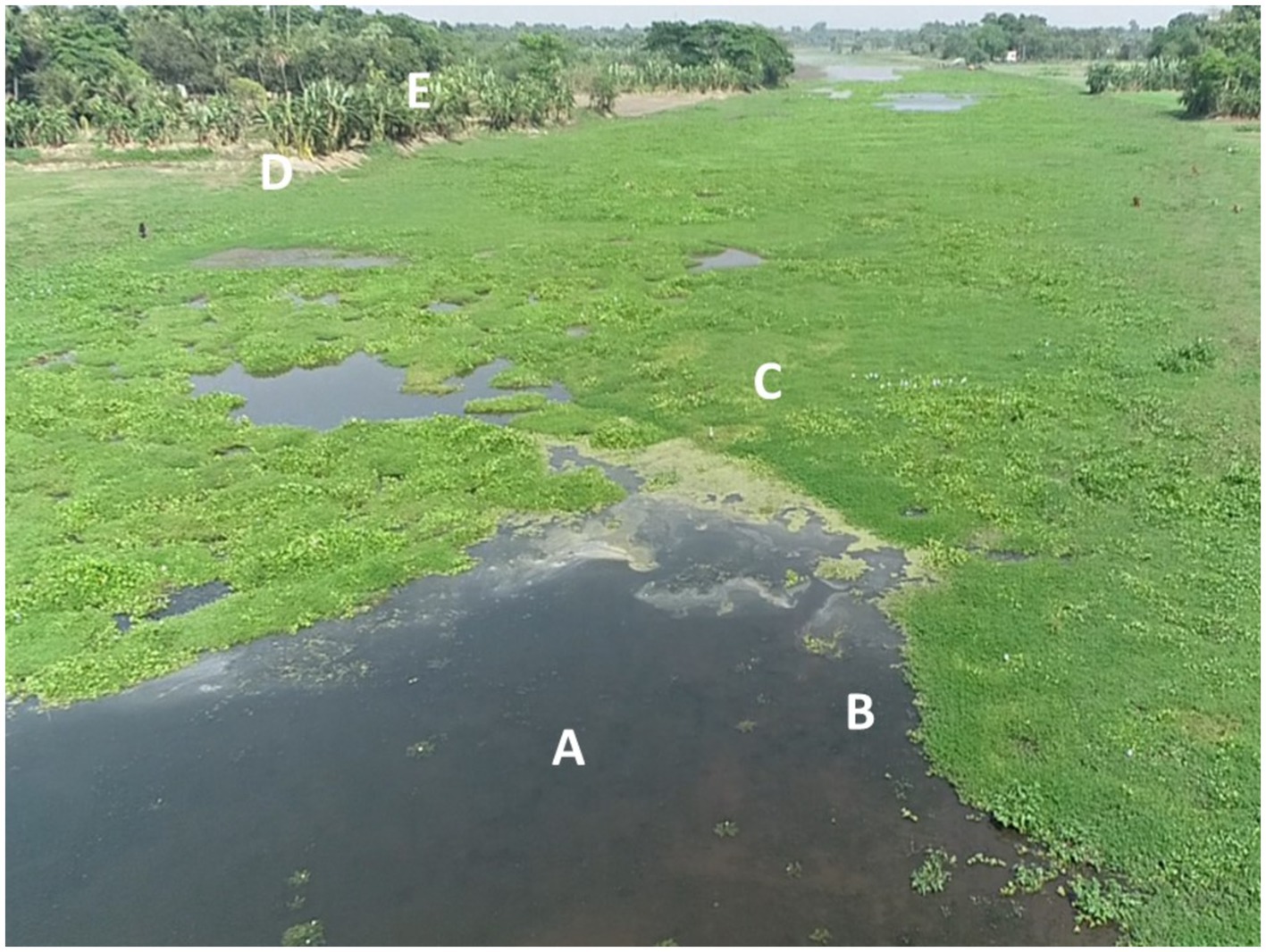
Figure 8. Drone captured image of macrophyte infestation in a part of Chamta wetland (A–water, B–submerged macrophytes, C–floating macrophytse, D–bank of wetland, E–other terrestrial plants).
However, the introduction of grass carp into aquatic ecosystems can lead to significant ecological impacts. Dibble and Kovalenko (2009) highlighted the potential impacts of grass carp on aquatic ecosystems and community structure. By consuming large amount of aquatic vegetation, grass carp reduce macrophyte cover, which disrupts benthic-pelagic coupling and nutrient cycling (Shurin et al., 2002). This can result in increased sediment resuspension and nutrient release, often causing algal blooms and shifts to turbid, un-vegetated states (Scheffer et al., 2001). Additionally, the loss of vegetated habitats affects the diversity and abundance of macroinvertebrates and fish dependent on macrophytes for food and refuge, potentially altering community structures and reducing ecosystem stability (Wetzel, 2001). Although the extent of macrophyte proliferation is very high in most of the floodplains and grass carp is already established in most of the aquatic ecosystem of the country, the above said effects highlight the importance of understanding and carefully managing their introduction to maintain ecosystem balance.
Olive barb S. sarana achieved the highest WG% and survival under the polyculture system. S. sarana has been previously reported to show encouraging growth in pond polyculture systems (Chakraborty et al., 2004; Jena et al., 2007). It is a highly preferred SIF in India’s eastern and northeastern states, fetching up to 300–400 INR/kg. Over the years, the natural stock of S. sarana has reduced due to habitat perturbations and overexploitation, making it a vulnerable species in India (Siddik et al., 2013). Owing to high consumer preference and a short production cycle, the species has been recommended for intercropping with IMCs and is also being advocated for cage production (Upadhyay et al., 2022). Indigenous cyprinid L. bata is an important SIF, known for its taste and nutritional value (Karnatak et al., 2021a). It fetches 200–250 INR/kg in eastern and Northeastern states of India. Its monoculture and polyculture with other carp species are generally practiced in ponds and is now being opted for culture in open water enclosures (Yengkokpam et al., 2020; Debnath et al., 2022). Despite being classified as “least concern” by the IUCN, its population is dwindling in natural waters and is endangered in Bangladesh (Rahman et al., 2012). Borah et al. (2023) studied the growth performance of L. bata in pens in wetlands of Assam and achieved an average weight of 61 to 80 g in 100 days at varying densities (3–9 Nos. m−2) in monoculture. The lower growth achieved in the present study might be due to high culture density and polyculture. The production of these SIFs through CBF can help reduce pressure on natural stocks.
In present study, the growth performance of IMCs (L. catla, L. rohita, and C. mrigala) measured in terms of ADG, SGR, WG %, FCR, PER and FCE was better during summer (March–May) than winter (November–January) which can be attributed to the difference in temperature regimes during culture periods. Lower growth of carps in lower temperature regimes has previously been reported for IMCs (Dhawan and Kaur, 2002), Grass carp (Shrestha, 1999; Karnatak et al., 2022), Koi carp (Jha et al., 2007), catfish (El-Sayed et al., 1996) and Tilapia (Usmani and Jafri, 2002). As fish is an ectothermic animal, seasonal variability in temperature influences their feeding behaviour, digestion and nutrient absorption and hence impacts fish growth in a culture system (Volkoff and Rønnestad, 2020).
The water quality parameters recorded at the pen culture site were observed in the range suitable for the culture of carps. The water quality parameters at the culture site did not differ significantly from the reference site, possibly due to the small-scale culture system (Devi et al., 2015). The higher nutrient concentration in the water can be attributed to fish feed and waste, while lower chlorophyll content might have resulted from plankton grazing by the stocked fish.
The fish produced in the pens were released to the wetland proper as input to CBF. Multiple stockings and harvesting are recommended and practiced in the wetlands (Sarkar et al., 2020). The stocking of overwintered seed is recommended to encash compensatory growth and achieve table size in a short duration by utilising primary productivity in the summer months. The fish stocked in June, which also coincides with the fishing ban month in wetlands can be harvested post-monsoon after the fishing ban is lifted. In enclosures, CBF seed reared in situ shows better wetland survival (Roy and Hassan, 2013).
S. sarana, L. bata grew to average size of 200 g and 150 g, in 6 months and 270 g and 200 g in 1 year. The adoption of pen culture in the Asom wetlands had a direct influence on fish production, household income and livelihood security for fishermen (Chandra et al., 2013). Both minor carps were observed to attain maturity in pens, indicating potential for conservation and production enhancement. However, the breeding success of mature SIFs released into wetlands remains uncertain, which is a major limitation of this study. The success of stock enhancement programs depends heavily on the reproductive success of released fish and their interactions with wild populations, which can significantly impact the ecological and genetic integrity of these populations (Fleming and Petersson, 2001). Effective stock enhancement in large reservoirs and wetlands requires that released fish not only survive but also breed and sustain their populations (Sugunan, 2010). This depends on understanding their breeding dynamics and ensuring suitable habitat and environmental conditions for juvenile recruitment (Bell et al., 2005). Systematic studies are essential to establish evidence of natural spawning success of released stock to evidence if such stock enhancement efforts contribute to sustainable population recovery and improved biodiversity in wetlands.
The economics of the two polyculture trials showed a profitable BC ratio. The present study considered only fingerling raising; however, these pens can also be utilized for the production of high value table-fish (Borah et al., 2023; Paul et al., 2019) providing an additional source of income. Furthermore, utilizing the pens for self-recruiting SIFs (small indigenous fishes) can contribute to SIFs conservation (Yengkokpam et al., 2022). The seed production in pens is more economical than pond raising as it utilises the natural production of the water body. Also, due to continuous water exchange and lower nutrient accumulation, the chance of disease occurrence is less. Given the results of the present study, a mere 0.5 ha pen can produce around 1 lakh advanced fingerlings at a time which is enough to fulfil the recommended stocking rate (2,000/ha) for CBF (Sarkar et al., 2020). Since multiple crops can be taken from these enclosures, the additional seed produced in the pens can also be supplied/ sold to FCS of nearby wetlands to generate additional income.
In-situ seed production in pens is an economically feasible technology to boost CBF in wetlands. The in situ raising assures the production of the recommended size of fingerlings for CBF and better survival in the wetland owing to acclimatization in the same aquatic environment. The pens can be used effectively for seed raising, breeding of self-recruiting species and table fish production. The implementation of technology in participatory mode is effective in transmitting the knowledge as it promotes “learning by doing” (Olarinde et al., 2017; de Souza et al., 2012). Integration of need-based grass carp in CBF (based on macrophyte type and percentage level) can certainly enhance fish production from macrophyte-infested wetlands. However, large-scale feed-based pen aquaculture in wetlands can significantly impact ecological balance and biodiversity (Chen et al., 2007). It increases nutrient loading leading to eutrophication (Li et al., 2022) and phytoplankton biomass in culture areas, as seen in Lake Honghu, leading to eutrophication and water quality degradation (Yang and Wang, 2003). Intensified competition for food and space among species can alter habitats and contribute to native species decline (Lin et al., 2015). In floodplain lakes along the Yangtze River, pen aquaculture has been linked to reduced alpha diversity and homogenization of fish communities, threatening ecosystem resilience (Jiang et al., 2019). Moreover, these activities can negatively impact waterbird populations, as observed in Caizi Lake of China (Liu et al., 2024). These findings underscore the need for sustainable management practices in pen aquaculture to mitigate its ecological impacts.
5 Conclusion
The integration of pen culture into CBF can enhance production and promote sustainable fisheries in these floodplain wetlands. The present study demonstrates that the adoption of pen culture resulted in a significant increase in fish production. However, the effectiveness of this intervention may vary across different ecosystems, seasons, geographical regions, and species of interest. Variability in these factors could influence the overall success and sustainability of pen culture as a method for enhancing fish production. Therefore, to gain a more comprehensive understanding of the economic feasibility and potential long-term impact of pen culture on wetland fish production, it is essential to conduct trials in a broader range of wetlands across various agroclimatic zones. Such research would provide valuable insights into the general applicability and scalability of pen culture in diverse environmental and socio-economic contexts. SIFs are an integral part of the wetland fisheries. Although low yielding, these species fetch high prices in the local markets and contribute to fisher families’ household nutrition requirements. For success of SIF stock enhancement programmes in wetlands, the natural breeding of the released stock in wetlands needs to be established through further studies for evaluating the sustainability of this approach. The production of these high value species in pens can also provide additional income to the fishers and also reduce fishing pressure on natural stocks. The enhanced species diversity and production will contribute towards ecosystem resilience and reduce the vulnerability in the climate change scenario. The introduction of macrophyte-utilizing species, such as grass carp, can serve a dual purpose by enhancing fish production and aiding in macrophyte management within wetlands. However, it is crucial to assess how such introductions may impact the ecological balance and community structure of wetlands. This requires the collection of primary evidence and the development of predictive ecological models to understand the long-term effects, ensuring that ecosystem integrity is maintained. Such studies are essential for determining the sustainability of grass carp introductions and minimizing potential ecological disruptions. As demonstrated in the present study, pen culture technology holds considerable potential for enhancing fish production in wetlands. However, its implementation and expansion must be approached with caution. Systematic impact assessment studies are needed to document potential ecological risk ensuring the adoption of sustainable management practices and maintain long-term environmental balance. To ensure the long-term viability of both fisheries and wetland ecosystems, it is crucial to balance production benefits with ecological preservation, prioritizing careful planning and scientifically informed interventions.
Data availability statement
The original contributions presented in the study are included in the article/supplementary material, further inquiries can be directed to the corresponding author.
Ethics statement
The animal study was approved by Institute Animal Ethics Committee (ICAR-CIFRI). The study was conducted in accordance with the local legislation and institutional requirements.
Author contributions
GK: Conceptualization, Investigation, Methodology, Writing – original draft. BD: Project administration, Supervision, Writing – review & editing. PP: Writing – review & editing. AR: Formal analysis, Writing – review & editing. AD: Supervision, Writing – review & editing. LL: Visualization, Writing – review & editing. AE: Formal analysis, Writing – review & editing. SC: Investigation, Writing – review & editing. KM: Investigation, Writing – review & editing. SD: Investigation, Writing – review & editing.
Funding
The author(s) declare that financial support was received for the research, authorship, and/or publication of this article. This work was supported by WorldFish under the ICAR-WorldFish collaborative (W-3) project “Small-scale fisheries in wetlands for livelihood and nutritional security.”
Acknowledgments
Participation and cooperation of the Chamta fishermen cooperative society in providing data and implementation of project activities in co-management mode is greatly acknowledged.
Conflict of interest
The authors declare that the research was conducted in the absence of any commercial or financial relationships that could be construed as a potential conflict of interest.
Generative AI statement
The authors declare that no Gen AI was used in the creation of this manuscript.
Publisher’s note
All claims expressed in this article are solely those of the authors and do not necessarily represent those of their affiliated organizations, or those of the publisher, the editors and the reviewers. Any product that may be evaluated in this article, or claim that may be made by its manufacturer, is not guaranteed or endorsed by the publisher.
References
Alam, A., Joshi, K. D., Das, S. C. S., Jha, D. N., Srivastava, K., Kumar, V., et al. (2017). Enhancing fish productivity through pen culture: a case study in Sareni wetland of Uttar Pradesh. Indian J. Fish. 64, 8–13. doi: 10.21077/ijf.2017.64.special-issue.76184-02
Aloo, P., Ojwang, W., Omondi, R., Njiru, J. M., and Oyugi, D. (2013). A review of the impacts of invasive aquatic weeds on the biodiversity of some tropical water bodies with special reference to Lake Victoria (Kenya). Biodiversity J. 4, 471–482.
APHA (2012). Standard methods for examination of water and waste water. 22nd Edn. Washington, DC: American Public Health Association.
Aziz, M. S. B., Hasan, N. A., Mondol, M. M. R., Alam, M. M., and Haque, M. M. (2021). Decline in fish species diversity due to climatic and anthropogenic factors in Hakaluki Haor, an ecologically critical wetland in Northeast Bangladesh. Heliyon. 7:e05861. doi: 10.1016/j.heliyon.2020.e05861
Bell, J. D., Rothlisberg, P. C., Munro, J. L., Loneragan, N. R., and Nash, W. J. (2005). Restocking and stock enhancement of marine invertebrate fisheries. Advances in Marine Biology. eds. A. J. Southward, C. M. Young, and L. A. Fuiman (Oxford,UK: Elsevier).
Bhattacharjya, B. K., Sona, Y., Pranab, G., Sarma, K. K., and Dipesh, D. (2015). Rearing of carried over carp seed in pen enclosure in a closed floodplain wetland of Assam. Indian J. Fish. 47, 43–48.
Borah, S., Das, B. K., Bhattacharjya, B. K., Karnatak, G., Yadav, A. K., Pandit, A., et al. (2023). Standardizing pen culture of small indigenous fish Labeo bata in the tropical floodplain wetland of the north eastern region, India: a step towards sustainable fisheries management. Sustain. For. 15:4423. doi: 10.3390/su15054423
Chakraborty, B. K., Miah, M. I., Mirza, M. J. A., and Habib, M. A. B. (2004). Growth performance of endangered Puntius sarana (Hamilton) under semi-intensive polyculture system. Bangladesh J. Fish. 28, 51–61.
Chandra, G., Sharma, A., and Sahu, S. (2013). Impact of pen-culture technology on fish productivity of floodplain wetlands in Asom. Indian J. Anim. Sci. 83, 209–215.
Chen, J. X., Guang, C. T., Xu, H., Chen, Z. X., Xu, P., Yan, X. M., et al. (2007). “A review of cage and pen culture: China” in Cage aquaculture: Regional reviews and global overview. eds. H. Matthias, S. Doris, and J. R. Arthur (Italy, Rome: Food and Agriculture Organization of the United Nations), 53–72.
Das, A., Bhattacharjya, B. K., Goswami, S. N., Sawant, P. B., Debnath, D., Yengkokpam, S., et al. (2017). Assessment of economic feasibility of pen aquaculture technology in floodplain wetlands (beels) of Assam, India. Indian J. Fish. 64, 1–7. doi: 10.21077/ijf.2017.64.special-issue.76180-01
Das Sarkar, S., Sarkar, U. K., Lianthuamluaia, L., Ghosh, B. D., Roy, K., Mishal, P., et al. (2020). Pattern of the state of eutrophication in the floodplain wetlands of eastern India in context of climate change: a comparative evaluation of 27 wetlands. Environ. Monit. Assess. 192:183. doi: 10.1007/s10661-020-8114-8
de Souza, H. N., Cardoso, I. M., de Sá Mendonça, E., Carvalho, A. F., de Oliveira, G. B., Gjorup, D. F., et al. (2012). Learning by doing: a participatory methodology for systematization of experiments with agroforestry systems, with an example of its application. Agrofor. Syst. 85, 247–262. doi: 10.1007/s10457-012-9498-4
Debnath, D., Das, B. K., Yengkokpam, S., Das, P., Yadav, A. K., Sharma, N., et al. (2022). Evaluating growth, production and economics of a new candidate species Labeo bata in cages: a regional model for table fish production in floodplain wetlands of north East India. Aquaculture 546:737344. doi: 10.1016/j.aquaculture.2021.737344
Deka, U., and Sarma, S. K. (2014). Present status of aquatic macrophytes of the wetlands of Nalbari district of Assam, India. Asian J. Plant Sci. Res. 4, 67–75.
Devi, P. A., Padmavathy, P., Srinivasan, A., and Jawahar, P. (2015). Environmental impact of cage culture on Poondi reservoir, Tamil Nadu. Curr. World Environ. 10, 1048–1054. doi: 10.12944/CWE.10.3.39
Dhawan, A., and Kaur, S. (2002). Effect of pig dung on water quality and polyculture of carp species during winter and summer. Aquac. Int. 10, 297–307. doi: 10.1023/A:1022406800631
Dibble, E. D., and Kovalenko, K. (2009). Ecological impact of grass carp: a review of the available data. J. Aquat. Plant Manag. 47, 1–15.
DoF West Bengal (2016). Handbook of fisheries statistics. Salt Lake City: Department of Fisheries, Government of West Bengal, Meen Bhavan.
El-Sayed, A. F., El-Ghobashy, A., and Al-Amoudi, M. (1996). Effects of pond depth and water temperature on the growth, mortality and body composition of Nile tilapia, Oreochromis niloticus (L.). Aquac. Res. 27, 681–687. doi: 10.1046/j.1365-2109.1996.00776.x
Fleming, I. A., and Petersson, E. (2001). The ability of released, hatchery salmonids to breed and contribute to the natural productivity of wild populations. Nord. J. Freshw. Res., 75, 71–98.
Jena, J. K., Das, P. C., Das, R., and Mondal, S. (2007). Performance of olive barb, Puntius sarana (Hamilton) in fingerling rearing with rohu, Labeo rohita (Hamilton) and mrigal, Cirrhinus mrigala (Hamilton). Aquaculture 265, 305–308. doi: 10.1016/j.aquaculture.2007.01.008
Jha, P., Barat, S., and Sarkar, K. (2007). Comparative effect of live food and manured treatments on water quality and production of ornamental carp, Cyprinus carpio var. koi L., during winter, summer, monsoon and post-monsoon growout experiments in concrete tanks. J. Appl. Ichthyol. 23, 87–92. doi: 10.1111/j.1439-0426.2006.00788.x
Jha, B. C., Bhattacharjya, B. K., Suresh, V. R., Chandra, G., Sugunan, V. V., and Sharma, A. P. (2013). “Success stories of stock enhancement in floodplain wetlands in Assam, Bihar and West Bengal and their economic, environmental and social implication” in Recent advances in culture-based fisheries in India. eds. V. V. Sugunan, A. P. Sharma, and B. C. Jha (New Delhi: Hindustan Publishing Corporation), 53–67.
Jiang, Z., Wang, C., Zhou, L., Xiong, W., and Liu, C. (2019). Impacts of pen culture on alpha and beta diversity of fish communities in a large floodplain lake along the Yangtze River. Fish. Res. 210, 41–49. doi: 10.1016/j.fishres.2018.10.007
Karnatak, G., Das, B. K., Mishal, P., Tayung, T., Kumari, S., Sarkar, U. K., et al. (2021a). Impact of stocking density on growth, feed utilization and survival of cage reared minor carp, Labeo bata (Hamilton, 1822) in Maithon reservoir, India. Aquaculture 532:736078. doi: 10.1016/j.aquaculture.2020.736078
Karnatak, G., Das, B. K., Puthiyottil, M., Tayung, T., Kumari, S., Lianthuamluaia, L., et al. (2021b). Environmental parameters and stocking density influence growth, feed utilization and economics of butter catfish, Ompok bimaculatus (Bloch, 1794) production in floating net cages in a large tropical reservoir, India. Environ. Sci. Pollut. Res. 28, 59720–59730. doi: 10.1007/s11356-021-14900-8
Karnatak, G., Das, B. K., Sarkar, U. K., Borah, S., Roy, A., Parida, P., et al. (2022). Integration of pen aquaculture into ecosystem-based enhancement of small-scale fisheries in a macrophyte dominated floodplain wetland of India. Environ. Sci. Pollut. Res. 29, 75431–75440. doi: 10.1007/s11356-022-21112-1
Karnatak, G., Sarkar, U. K., Puthiyottil, M., Lianthuamluaia, L., Ghosh, B. D., Bakshi, S., et al. (2021c). Enhancing adaptive capacity of wetland fishers through pen culture in the face of changing climate: a study from a tropical wetland, India. Aquat. Ecosyst. Health Manag. 24, 83–93. doi: 10.14321/aehm.024.03.10
Li, X., Zhu, T., He, Y., Wu, X., Zhu, Y., and Yang, D. (2022). Assessment of eutrophication and nitrogen and phosphorus carrying capacity before and after removing pen culture (2013–2018) in Lake Changhu, China. Environ. Sci. Pollut. Res. 29, 5674–5686. doi: 10.1007/s11356-021-15908-w
Lin, Y., Gao, Z., and Zhan, A. (2015). Introduction and use of non-native species for aquaculture in China: status, risks and management solutions. Rev. Aquac. 7, 28–58. doi: 10.1111/raq.12052
Liu, T., Cheng, L., Song, X., Zhang, H., Wang, G., and Li, C. (2024). Differences in Waterbird communities between years indicate the positive effects of pen culture removal in Caizi Lake, a typical Yangtze-connected Lake. Ecologies 5, 296–311. doi: 10.3390/ecologies5020019
Liu, B., Xu, M., Henderson, M., Qi, Y., and Li, Y. (2004). Taking China's temperature: daily range, warming trends, and regional variations, 1955–2000. J. Clim. 17, 4453–4462. doi: 10.1175/3230.1
Olarinde, L., Binam, J., Fatunbi, A. O., Diagne, A., Adekunle, A., and Ayanwale, A. (2017). Participatory research demonstration and its impact on the adoption of improved agricultural technologies in the savannas of West Africa. Afr. Crop. Sci. J. 25, 21–41. doi: 10.4314/acsj.v25i1.3S
Pai, D. S., Rajeevan, M., Sreejith, O. P., Mukhopadhyay, B., and Satbha, N. S. (2014). Development of a new high spatial resolution (0.25 × 0.25) long period (1901-2010) daily gridded rainfall data set over India and its comparison with existing data sets over the region. Mausam 65, 1–18. doi: 10.54302/mausam.v65i1.851
Pandit, D., Saha, S., Kunda, M., and Harun-Al-Rashid, A. (2021). Indigenous freshwater ichthyofauna in the Dhanu River and surrounding wetlands of Bangladesh: species diversity, availability, and conservation perspectives. Conservation. 1, 241–257. doi: 10.3390/conservation1030019
Paul, T. T., Kuberan, G., Preetha, P., Deepa, S., Sarkar, U. K., and Das, B. K. (2019). Demonstration of a climate-resilient multitrophic pen system in Vembanad Lake, Kerala, India. World Aquac. 50, 56–58.
Paul, T. T., Panikker, P., Sarkar, U. K., Manoharan, S., Kuberan, G., Sreenath, K. R., et al. (2021). Assessing vulnerability and adopting alternative climate resilient strategies for livelihood security and sustainable management of aquatic biodiversity of Vembanad lake in India. J. Water Clim. Change. 12, 1310–1326. doi: 10.2166/wcc.2020.194
Pípalová, I. (2006). “A review of grass carp use for aquatic weed control and its impact on water bodies,” in J. Aquat. Plant Manag. 44, 1–12.
Puthiyottil, M., Sarkar, U. K., Lianthuamluaia, L., Karnatak, G., Hassan, M. A., Kumari, S., et al. (2021). Floodplain wetlands of eastern India in a changing climate: trophic characterization, ecological status, and implications for fisheries. Aquat. Ecosyst. Health Manage. 24, 47–56. doi: 10.14321/aehm.024.03.07
Rahman, M. M., Hossain, M. Y., Ahamed, F., Fatematuzzhura, S. B., Abdallah, E. M., and Ohtomi, J. (2012). Biodiversity in the Padma distributary of the Ganges River, northwestern Bangladesh: recommendations for conservation. WJZ. 7, 328–337. doi: 10.5829/idosi.wjz.2012.7.4.6634
Roy, A., and Hassan, M. A. (2013). Adoption of pen culture technology in wetlands of West Bengal, India. Fish. Technol. 50, 342–346.
Sarkar, U. K., Mishal, P., Borah, S., Karnatak, G., Chandra, G., Kumari, S., et al. (2020). Status, potential, prospects, and issues of floodplain wetland fisheries in India: synthesis and review for sustainable management. Rev. Fish. Sci. Aquac. 29, 1–32. doi: 10.1080/23308249.2020.1779650
Sarkar, U. K., Roy, K., Naskar, M., Srivastava, P. K., Bose, A. K., Verma, V. K., et al. (2019). Minnows may be more reproductively resilient to climatic variability than anticipated: synthesis from a reproductive vulnerability assessment of Gangetic pool barbs (Puntius sophore). Ecol. Indic. 105, 727–736. doi: 10.1016/j.ecolind.2019.03.037
Sarkar, S., Sarkar, U. K., Ali, S., Kumari, S., and Puthiyotti, M. (2021). Status, ecological services and management of aquatic weeds of floodplain wetlands in India: an overview. Lakes Reserv. Res. Manag. 26, 76–91. doi: 10.1111/lre.12353
Scheffer, M., Carpenter, S., Foley, J. A., Folke, C., and Walker, B. (2001). Catastrophic shifts in ecosystems. Nature 413, 591–596. doi: 10.1038/35098000
Sharma, A. P., Joshi, K. D., Naskar, M., and Das, M. K. (2014) Inland fisheries & climate change: vulnerability and adaptation options. NICRA.ICAR-CIFRI special publication, policy paper no.: NICRA/policy/2015-16/1.
Shrestha, M. K. (1999). Summer and winter growth of grass carp (Ctenopharyngodon idella) in a polyculture fed with napier grass (Pennisetum purpureum) in the subtropical climate of Nepal. J. Aquacult. Trop. 14, 57–64.
Shurin, J. B., Borer, E. T., Seabloom, E. W., Anderson, K., Blanchette, C. A., Broitman, B., et al. (2002). A cross-ecosystem comparison of the strength of trophic cascades. Ecol. Lett. 5, 785–791. doi: 10.1046/j.1461-0248.2002.00381.x
Siddik, M. A. B., Nahar, A., Ahamed, F., Masood, Z., and Hossain, M. Y. (2013). Conservation of critically endangered olive barb Puntius sarana (Hamilton, 1822) through artificial propagation. Our Nat. 11, 96–104. doi: 10.3126/on.v11i2.9534
Srivastava, A. K., Rajeevan, M., and Kshirsagar, S. R. (2009). Development of a high resolution daily gridded temperature data set (1969–2005) for the Indian region. Atmos. Sci. Lett. 10, 249–254. doi: 10.1002/asl.232
Sugunan, V. V. (2010). “Inland fisheries resource enhancement and conservation in India” in Inland fisheries resource enhancement and conservation in Asia, vol. 22 (Bangkok: FAO Regional office for Asia and the Pacific), 35–60.
Sugunan, V. V., and Bhattacharjya, B. K. (2000). Ecology and fisheries of beels in Assam. Central Inland Fisheries Research Institute, Bulletin No., 104, 1–65.
Sugunan, V. V., Vinci, G. K., Bhattacharjya, B. K., and Hassan, M. A. (2000). Ecology and Fisheries of Beels in West Bengal (p. 73). ICAR-Central Inland Fisheries Research Institute. Bulletin No. 103
Thomaz, S. M., and da Cunha, E. R. (2010). The role of macrophytes in habitat structuring in aquatic ecosystems: methods of measurement, causes and consequences on animal assemblages’ composition and biodiversity. Acta Limnol. Bras. 22, 218–236. doi: 10.4322/actalb.02202011
Upadhyay, A., Swain, H. S., Das, B. K., Ramteke, M. H., Kumar, V., Krishna, G., et al. (2022). Stocking density matters in open water cage culture: influence on growth, digestive enzymes, haemato-immuno and stress responses of Puntius sarana (Ham, 1822). Aquaculture 547:737445. doi: 10.1016/j.aquaculture.2021.737445
Usmani, N., and Jafri, A. K. (2002). Effect of fish size and temperature on the utilization of different protein sources in two catfish species. Aquac. Rep. 33, 959–967. doi: 10.1046/j.1365-2109.2002.00747.x
Vasudevappa, C., and Sultan, S. (2013). “Culture based fisheries in inland open waters: some recent initiatives to increase production, future plans and major constraints” in Recent advances in culture-based fisheries in India. eds. V. V. Sugunan, A. P. Sharma, and B. C. Jha (New Delhi: Hindustan Publishing Corporation), 41–52.
Volkoff, H., and Rønnestad, I. (2020). Effects of temperature on feeding and digestive processes in fish. Temperature. 7, 307–320. doi: 10.1080/23328940.2020.1765950
Yang, G. S., and Wang, D. J. (2003). Economical development, water environment and water calamity Taihu Basin. Beijing: Science Press, 26–32.
Yengkokpam, S., Das, B. K., Debnath, D., Das, P., Yadav, A. K., Sharma, N., et al. (2020). Effect of stocking density on growth and yield of Labeo bata fingerlings reared in cages. Aquac. Rep. 18:100506. doi: 10.1016/j.aqrep.2020.100506
Yengkokpam, S., Debnath, D., Bhattacharjya, B. K., Sarkar, U. K., Medhi, K., Gogoi, K., et al. (2022). Exploring polyculture of small indigenous fishes with major carps in pens as a climate-resilient adaptation strategy for northeastern wetlands of India. Mitig. Adapt. Strateg. Glob. Chang. 27, 1–19. doi: 10.1007/s11027-021-09981-2
Keywords: wetland, pen culture, culture-based fisheries, macrophyte management, small indigenous fishes, production and conservation
Citation: Karnatak G, Das BK, Parida P, Roy A, Das AK, Lianthuamluaia L, Ekka A, Chakraborty S, Mondal K and Debnath S (2025) Effectiveness of pen aquaculture in enhancing small scale fisheries production and conservation in a wetland of India. Front. Sustain. Food Syst. 8:1506096. doi: 10.3389/fsufs.2024.1506096
Edited by:
Abebe Getahun, Addis Ababa University, EthiopiaReviewed by:
Reuben Omondi, Kisii University, KenyaAkewake Geremew, Addis Ababa University, Ethiopia
Copyright © 2025 Karnatak, Das, Parida, Roy, Das, Lianthuamluaia, Ekka, Chakraborty, Mondal and Debnath. This is an open-access article distributed under the terms of the Creative Commons Attribution License (CC BY). The use, distribution or reproduction in other forums is permitted, provided the original author(s) and the copyright owner(s) are credited and that the original publication in this journal is cited, in accordance with accepted academic practice. No use, distribution or reproduction is permitted which does not comply with these terms.
*Correspondence: Basanta Kumar Das, YmFzYW50YWt1bWFyZEBnbWFpbC5jb20=
 Gunjan Karnatak
Gunjan Karnatak Basanta Kumar Das
Basanta Kumar Das Pranaya Parida
Pranaya Parida Aparna Roy
Aparna Roy Archan Kanti Das1
Archan Kanti Das1 Lianthuamluaia Lianthuamluaia
Lianthuamluaia Lianthuamluaia Sangeeta Chakraborty
Sangeeta Chakraborty Kausik Mondal
Kausik Mondal Sanjeet Debnath
Sanjeet Debnath